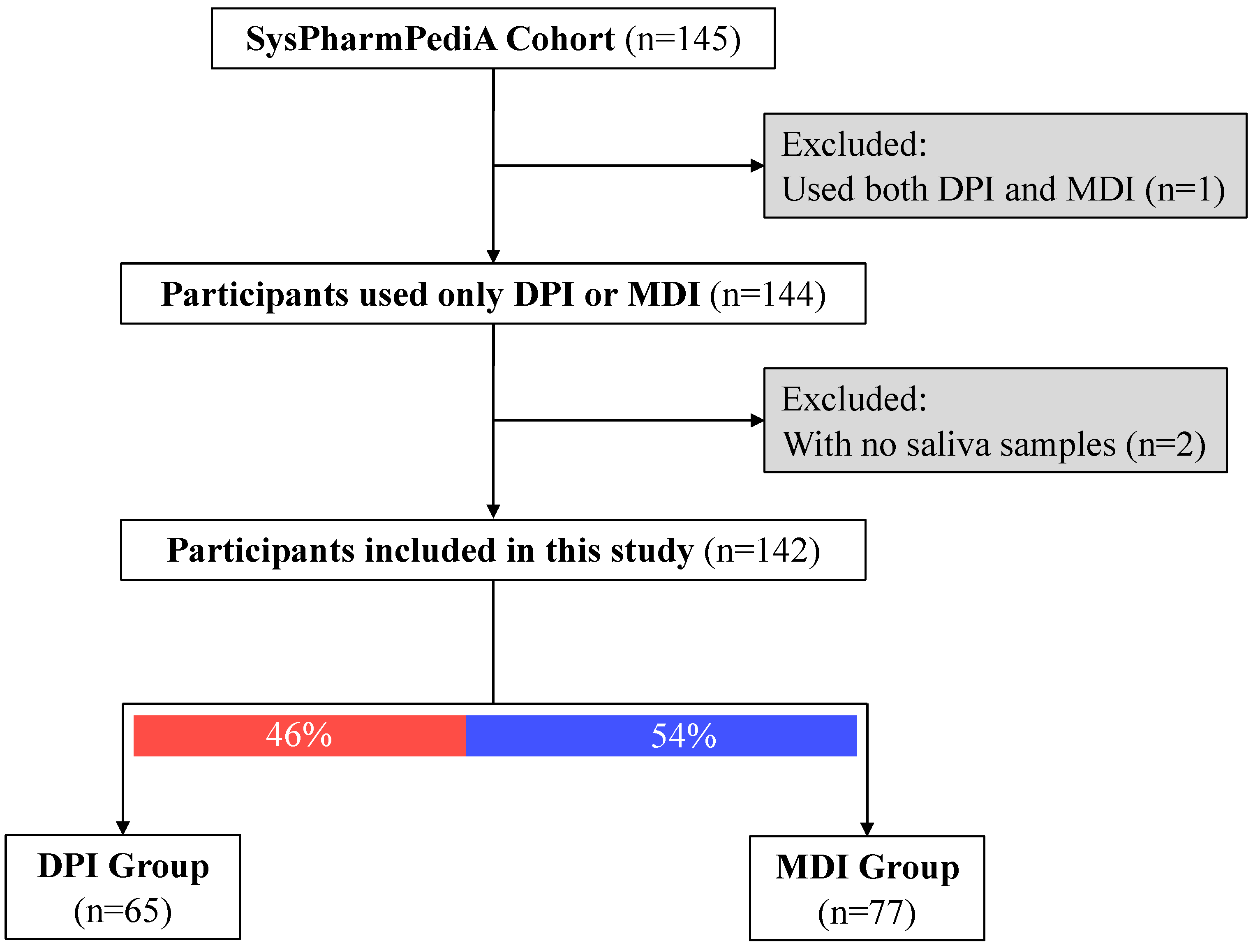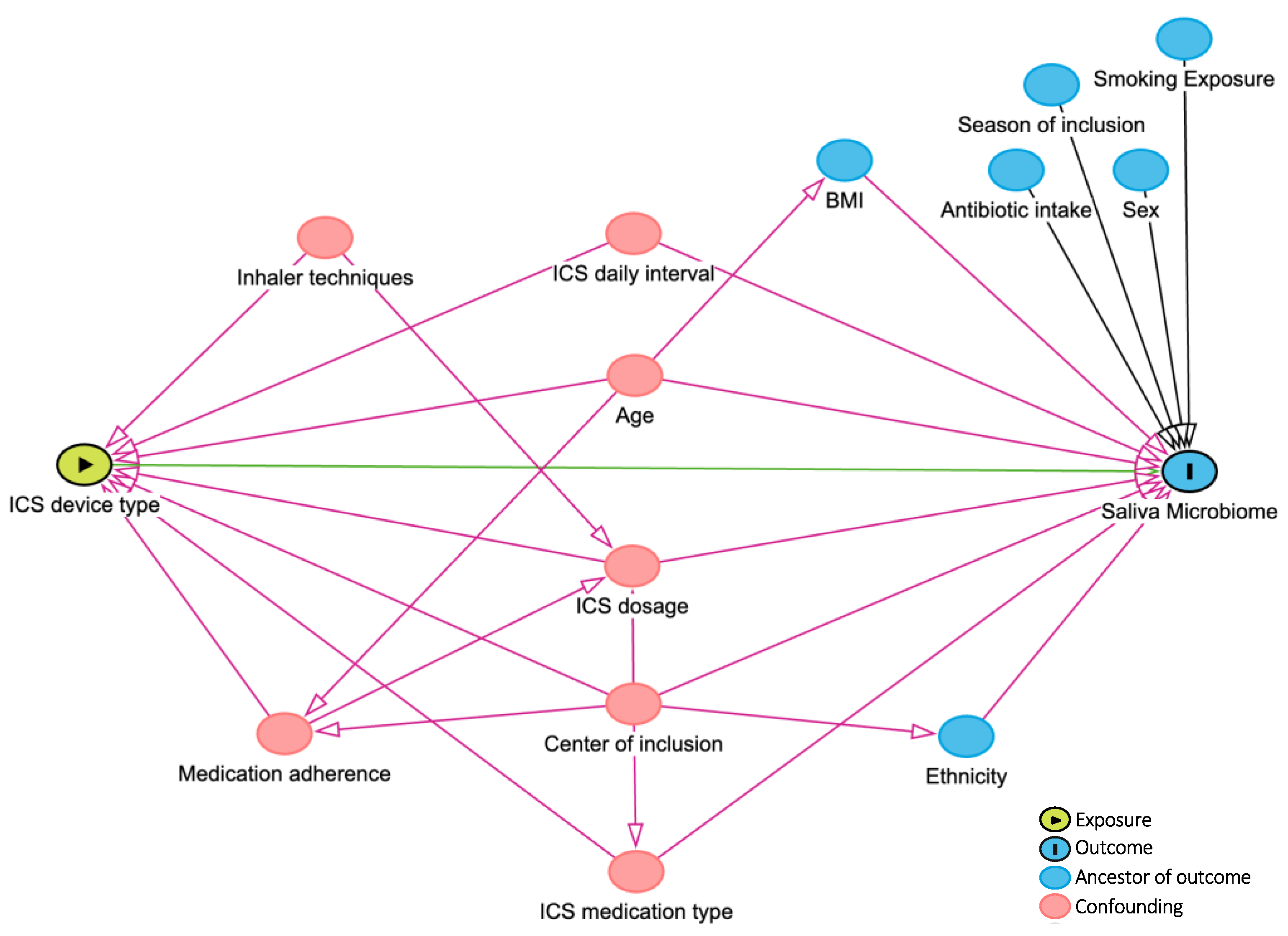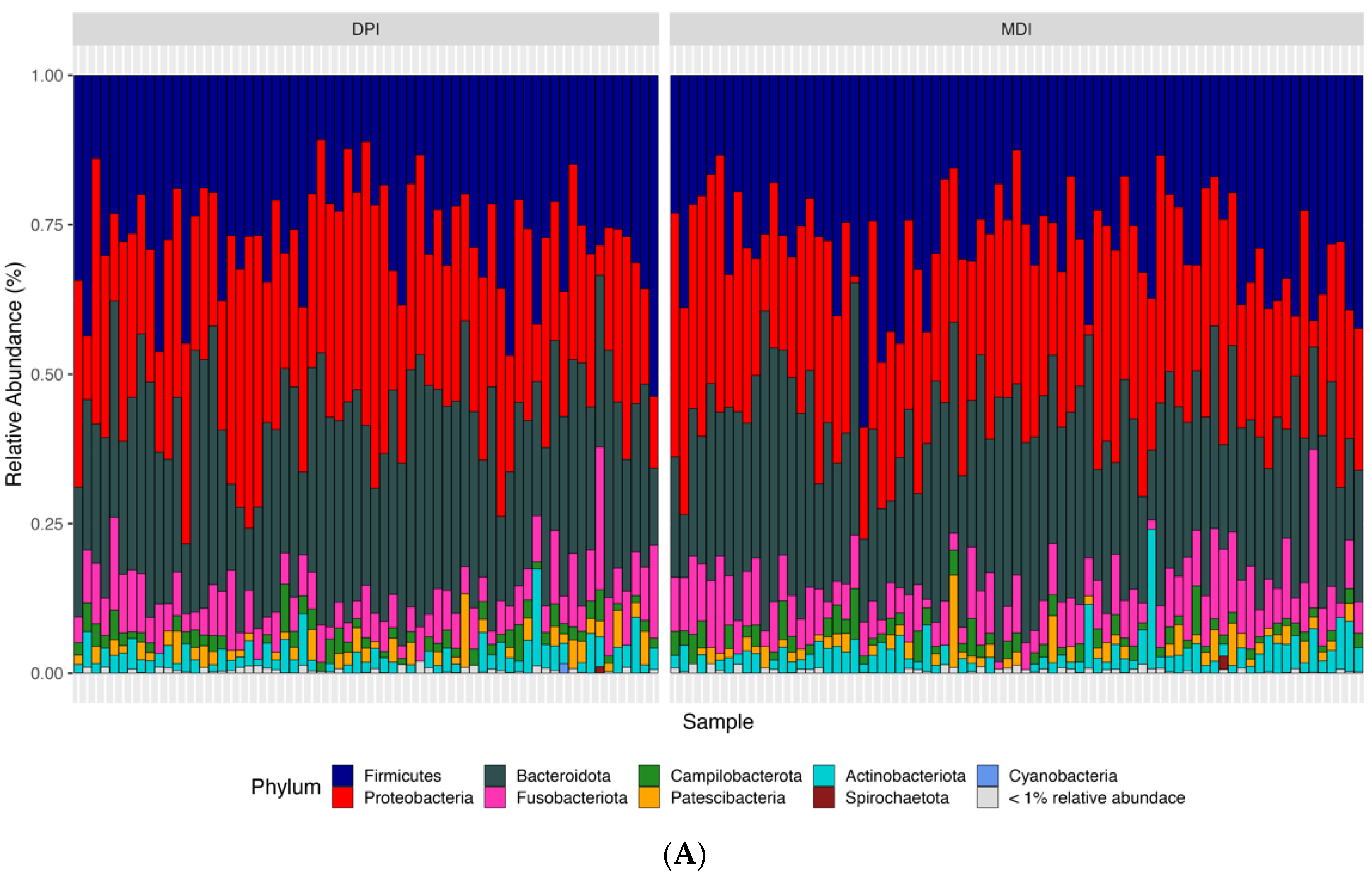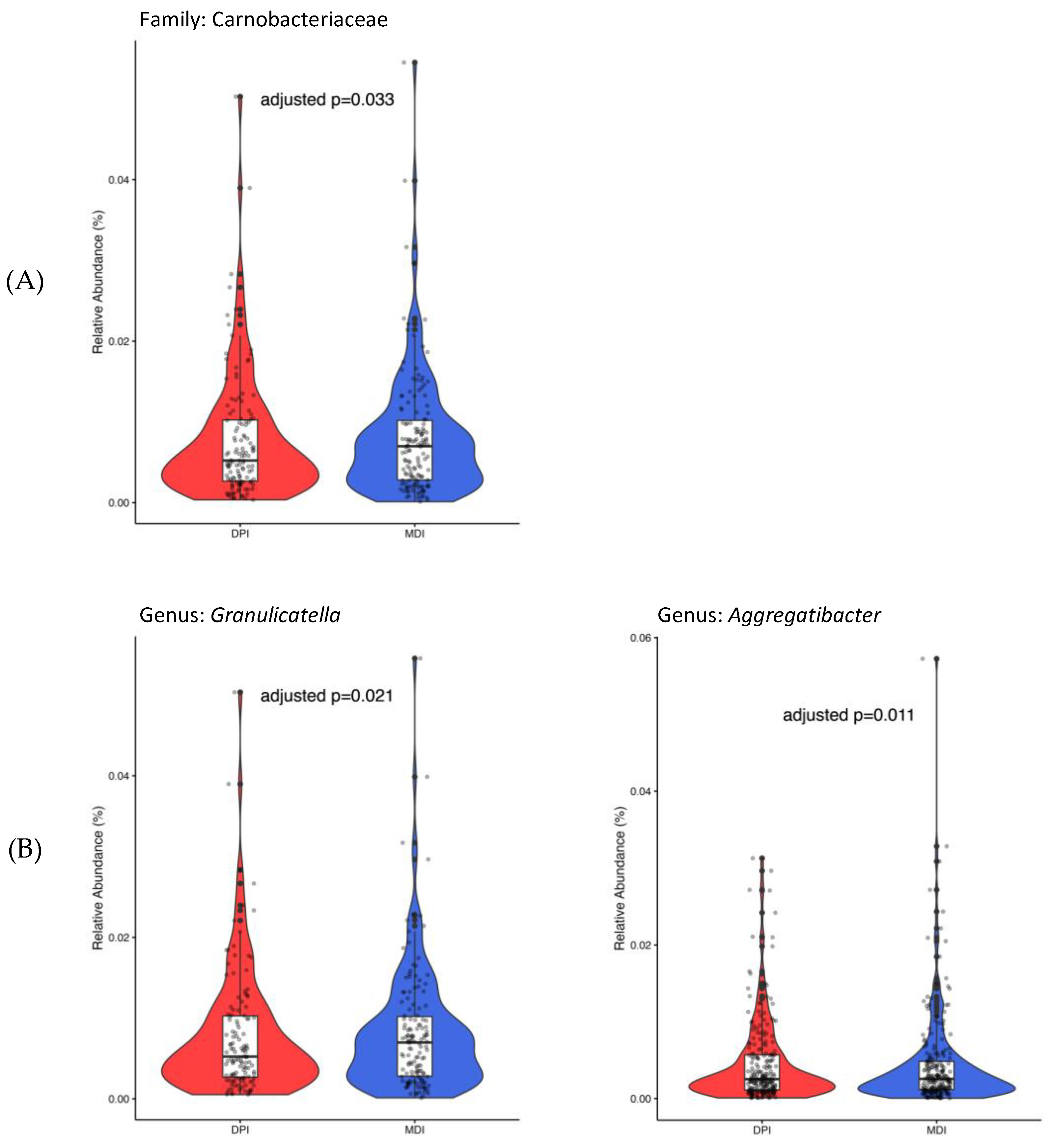Association of Corticosteroid Inhaler Type with Saliva Microbiome in Moderate-to-Severe Pediatric Asthma
Abstract
:1. Introduction
2. Materials and Methods
2.1. Study Design
2.2. Study Population
2.3. Saliva Sample Collection, 16S rRNA Sequencing and Processing
2.4. Statistical Analysis
3. Results
3.1. Global Diversity
3.2. Differential Abundance
4. Discussion
5. Conclusions
Author Contributions
Funding
Institutional Review Board Statement
Informed Consent Statement
Data Availability Statement
Acknowledgments
Conflicts of Interest
Abbreviations
References
- Global INitiative for Asthma, Global Strategy for Asthma Management and Prevention. 2023. Updated July 2023. Available online: www.ginasthma.org (accessed on 1 September 2023).
- Alizadeh Bahmani, A.H.; Abdel-Aziz, M.I.; Maitland-van der Zee, A.H.; Vijverberg, S.J.H. Recent advances in the treatment of childhood asthma: A clinical pharmacology perspective. Expert. Rev. Clin. Pharmacol. 2022, 15, 1165–1176. [Google Scholar] [CrossRef] [PubMed]
- Huang, C.; Ni, Y.; Du, W.; Shi, G. Effect of inhaled corticosteroids on microbiome and microbial correlations in asthma over a 9-month period. Clin. Transl. Sci. 2022, 15, 1723–1736. [Google Scholar] [CrossRef]
- Perez-Garcia, J.; González-Carracedo, M.; Espuela-Ortiz, A.; Hernández-Pérez, J.M.; González-Pérez, R.; Sardón-Prado, O.; Martin-Gonzalez, E.; Mederos-Luis, E.; Poza-Guedes, P.; Corcuera-Elosegui, P.; et al. The upper-airway microbiome as a biomarker of asthma exacerbations despite inhaled corticosteroid treatment. J. Allergy Clin. Immunol. 2023, 151, 706–715. [Google Scholar] [CrossRef]
- Beeh, K.M.; Kuna, P.; Corradi, M.; Viaud, I.; Guasconi, A.; Georges, G. Comparison of Dry-Powder Inhaler and Pressurized Metered-Dose Inhaler Formulations of Extrafine Beclomethasone Dipropionate/Formoterol Fumarate/Glycopyrronium in Patients with COPD: The TRI-D Randomized Controlled Trial. Int. J. Chron. Obs. Pulmon Dis. 2021, 16, 79–89. [Google Scholar] [CrossRef] [PubMed]
- Usmani, O.S. Choosing the right inhaler for your asthma or COPD patient. Ther. Clin. Risk Manag. 2019, 15, 461–472. [Google Scholar] [CrossRef] [PubMed]
- Rachelefsky, G.S.; Liao, Y.; Faruqi, R. Impact of inhaled corticosteroid-induced oropharyngeal adverse events: Results from a meta-analysis. Ann. Allergy Asthma Immunol. 2007, 98, 225–238. [Google Scholar] [CrossRef] [PubMed]
- Momeni, S.; Nokhodchi, A.; Ghanbarzadeh, S.; Hamishehkar, H. The Effect of Spacer Morphology on the Aerosolization Performance of Metered-Dose Inhalers. Adv. Pharm. Bull. 2016, 6, 257–260. [Google Scholar] [CrossRef] [PubMed]
- Ding, B.; Small, M.; Scheffel, G.; Holmgren, U. Maintenance inhaler preference, attribute importance, and satisfaction in prescribing physicians and patients with asthma, COPD, or asthma-COPD overlap syndrome consulting for routine care. Int. J. Chron. Obs. Pulmon Dis. 2018, 13, 927–936. [Google Scholar] [CrossRef] [PubMed]
- Ramadan, W.H.; Sarkis, A.T. Patterns of use of dry powder inhalers versus pressurized metered-dose inhalers devices in adult patients with chronic obstructive pulmonary disease or asthma: An observational comparative study. Chron. Respir. Dis. 2017, 14, 309–320. [Google Scholar] [CrossRef]
- Li, R.; Li, J.; Zhou, X. Lung microbiome: New insights into the pathogenesis of respiratory diseases. Signal Transduct. Target. Ther. 2024, 9, 19. [Google Scholar] [CrossRef] [PubMed]
- Belstrøm, D.; Holmstrup, P.; Bardow, A.; Kokaras, A.; Fiehn, N.E.; Paster, B.J. Comparative analysis of bacterial profiles in unstimulated and stimulated saliva samples. J. Oral. Microbiol. 2016, 8, 30112. [Google Scholar] [CrossRef]
- Hartmann, J.E.; Albrich, W.C.; Dmitrijeva, M.; Kahlert, C.R. The Effects of Corticosteroids on the Respiratory Microbiome: A Systematic Review. Front. Med. 2021, 8, 588584. [Google Scholar] [CrossRef] [PubMed]
- Abdel-Aziz, M.I.; Neerincx, A.H.; Vijverberg, S.J.H.; Hashimoto, S.; Brinkman, P.; Gorenjak, M.; Toncheva, A.A.; Harner, S.; Brandstetter, S.; Wolff, C.; et al. A System Pharmacology Multi-Omics Approach toward Uncontrolled Pediatric Asthma. J. Pers. Med. 2021, 11, 484. [Google Scholar] [CrossRef] [PubMed]
- Alizadeh Bahmani, A.H.; Slob, E.M.A.; Bloemsma, L.D.; Brandstetter, S.; Corcuera-Elosegui, P.; Gorenjak, M.; Harner, S.; Hashimoto, S.; Hedman, A.M.; Kabesch, M.; et al. Medication use in uncontrolled pediatric asthma: Results from the SysPharmPediA study. Eur. J. Pharm. Sci. 2023, 181, 106360. [Google Scholar] [CrossRef] [PubMed]
- Blankestijn, J.M.; Lopez-Rincon, A.; Neerincx, A.H.; Vijverberg, S.J.H.; Hashimoto, S.; Gorenjak, M.; Sardón Prado, O.; Corcuera-Elosegui, P.; Korta-Murua, J.; Pino-Yanes, M.; et al. Classifying asthma control using salivary and fecal bacterial microbiome in children with moderate-to-severe asthma. Pediatr. Allergy Immunol. 2023, 34, e13919. [Google Scholar] [CrossRef] [PubMed]
- Ewels, P.; Magnusson, M.; Lundin, S.; Käller, M. MultiQC: Summarize analysis results for multiple tools and samples in a single report. Bioinformatics 2016, 32, 3047–3048. [Google Scholar] [CrossRef]
- Andrews, S. FastQC: A Quality Control Tool for High Throughput Sequence Data. [Cited 2022 January 10th]; ScienceOpen, Inc.: Burlington, MA, USA, 2010. [Google Scholar]
- Martin, M. Cutadapt removes adapter sequences from high-throughput sequencing reads. EMBnet. J. 2011, 17, 10–12. [Google Scholar] [CrossRef]
- Callahan, B.J.; McMurdie, P.J.; Rosen, M.J.; Han, A.W.; Johnson, A.J.; Holmes, S.P. DADA2: High-resolution sample inference from Illumina amplicon data. Nat. Methods 2016, 13, 581–583. [Google Scholar] [CrossRef]
- Quast, C.; Pruesse, E.; Yilmaz, P.; Gerken, J.; Schweer, T.; Yarza, P.; Peplies, J.; Glöckner, F.O. The SILVA ribosomal RNA gene database project: Improved data processing and web-based tools. Nucleic Acids Res. 2013, 41, D590–D596. [Google Scholar] [CrossRef]
- McMurdie, P.J.; Holmes, S. phyloseq: An R package for reproducible interactive analysis and graphics of microbiome census data. PLoS ONE 2013, 8, e61217. [Google Scholar] [CrossRef]
- Oksanen, J.; Blanchet, F.G.; Kindt, R.; Legendre, P.; Minchin, P.R.; O’hara, R.; Simpson, G.L.; Solymos, P.; Stevens, M.H.H.; Wagner, H. Community ecology package. R Package Version 2013, 2, 321–326. [Google Scholar]
- Lin, H.; Peddada, S.D. Analysis of compositions of microbiomes with bias correction. Nat. Commun. 2020, 11, 3514. [Google Scholar] [CrossRef]
- Sharma, D.; Paterson, A.D.; Xu, W. TaxoNN: Ensemble of neural networks on stratified microbiome data for disease prediction. Bioinformatics 2020, 36, 4544–4550. [Google Scholar] [CrossRef]
- Liu, A.H.; Zeiger, R.; Sorkness, C.; Mahr, T.; Ostrom, N.; Burgess, S.; Rosenzweig, J.C.; Manjunath, R. Development and cross-sectional validation of the Childhood Asthma Control Test. J. Allergy Clin. Immunol. 2007, 119, 817–825. [Google Scholar] [CrossRef]
- Nathan, R.A.; Sorkness, C.A.; Kosinski, M.; Schatz, M.; Li, J.T.; Marcus, P.; Murray, J.J.; Pendergraft, T.B. Development of the asthma control test: A survey for assessing asthma control. J. Allergy Clin. Immunol. 2004, 113, 59–65. [Google Scholar] [CrossRef]
- Karched, M.; Bhardwaj, R.G.; Asikainen, S.E. Coaggregation and biofilm growth of Granulicatella spp. with Fusobacterium nucleatum and Aggregatibacter actinomycetemcomitans. BMC Microbiol. 2015, 15, 114. [Google Scholar] [CrossRef]
- Aabed, K.; Moubayed, N.; Ramadan, R.S.; BinShabaib, M.S.; Alharthi, S.S. A population-based study of the salivary prevalence of Porphyromonas gingivalis and Aggregatibacter actinomycetemcomitans in Saudi Arabian adults with chronic periodontitis. Med. Microecol. 2023, 17, 100086. [Google Scholar] [CrossRef]
- Hyvärinen, K.; Laitinen, S.; Paju, S.; Hakala, A.; Suominen-Taipale, L.; Skurnik, M.; Könönen, E.; Pussinen, P.J. Detection and quantification of five major periodontal pathogens by single copy gene-based real-time PCR. Innate Immun. 2009, 15, 195–204. [Google Scholar] [CrossRef]
- Kim, J.-H.; Oh, J.-W.; Lee, Y.; Yun, J.-H.; Choi, S.-H.; Lee, D.-W. Quantification of bacteria in mouth-rinsing solution for the diagnosis of periodontal disease. J. Clin. Med. 2021, 10, 891. [Google Scholar] [CrossRef]
- Rubin, L.G. 181—Other Gram-Negative Coccobacilli. In Principles and Practice of Pediatric Infectious Diseases, 6th ed.; Long, S.S., Ed.; Elsevier: Philadelphia, PA, USA, 2023; pp. 985–986.e981. [Google Scholar]
- Haubek, D.; Ennibi, O.K.; Poulsen, K.; Vaeth, M.; Poulsen, S.; Kilian, M. Risk of aggressive periodontitis in adolescent carriers of the JP2 clone of Aggregatibacter (Actinobacillus) actinomycetemcomitans in Morocco: A prospective longitudinal cohort study. Lancet 2008, 371, 237–242. [Google Scholar] [CrossRef] [PubMed]
- Moraschini, V.; Calasans-Maia, J.A.; Calasans-Maia, M.D. Association between asthma and periodontal disease: A systematic review and meta-analysis. J. Periodontol. 2018, 89, 440–455. [Google Scholar] [CrossRef] [PubMed]
- Belstrøm, D.; Fiehn, N.E.; Nielsen, C.H.; Kirkby, N.; Twetman, S.; Klepac-Ceraj, V.; Paster, B.J.; Holmstrup, P. Differences in bacterial saliva profile between periodontitis patients and a control cohort. J. Clin. Periodontol. 2014, 41, 104–112. [Google Scholar] [CrossRef] [PubMed]
- Kanasi, E.; Dewhirst, F.E.; Chalmers, N.I.; Kent, R., Jr.; Moore, A.; Hughes, C.V.; Pradhan, N.; Loo, C.Y.; Tanner, A.C. Clonal analysis of the microbiota of severe early childhood caries. Caries Res. 2010, 44, 485–497. [Google Scholar] [CrossRef]
- Hsiao, W.W.; Li, K.L.; Liu, Z.; Jones, C.; Fraser-Liggett, C.M.; Fouad, A.F. Microbial transformation from normal oral microbiota to acute endodontic infections. BMC Genom. 2012, 13, 345. [Google Scholar] [CrossRef]
- Siqueira, J.F., Jr.; Rôças, I.N. Catonella morbi and Granulicatella adiacens: New species in endodontic infections. Oral. Surg. Oral Med. Oral Pathol. Oral Radiol. Endod. 2006, 102, 259–264. [Google Scholar] [CrossRef] [PubMed]
- Heffler, E.; Madeira, L.N.G.; Ferrando, M.; Puggioni, F.; Racca, F.; Malvezzi, L.; Passalacqua, G.; Canonica, G.W. Inhaled Corticosteroids Safety and Adverse Effects in Patients with Asthma. J. Allergy Clin. Immunol. Pract. 2018, 6, 776–781. [Google Scholar] [CrossRef] [PubMed]
- Yang, I.A.; Clarke, M.S.; Sim, E.H.; Fong, K.M. Inhaled corticosteroids for stable chronic obstructive pulmonary disease. Cochrane Database Syst. Rev. 2012, 2012, Cd002991. [Google Scholar] [CrossRef]
- Zanobetti, A.; Ryan, P.H.; Coull, B.A.; Luttmann-Gibson, H.; Datta, S.; Blossom, J.; Brokamp, C.; Lothrop, N.; Miller, R.L.; Beamer, P.I.; et al. Early-Life Exposure to Air Pollution and Childhood Asthma Cumulative Incidence in the ECHO CREW Consortium. JAMA Netw. Open 2024, 7, e240535. [Google Scholar] [CrossRef]
- Dearborn, L.C.; Hazlehurst, M.F.; Loftus, C.T.; Szpiro, A.A.; Carroll, K.N.; Moore, P.E.; Adgent, M.A.; Barrett, E.S.; Nguyen, R.H.; Sathyanarayana, S.; et al. Role of Air Pollution in the Development of Asthma Among Children with a History of Bronchiolitis in Infancy. Epidemiology 2023, 34, 554–564. [Google Scholar] [CrossRef]





| Characteristics | DPI (n = 65) | MDI (n = 77) | p-Value | Total (n = 142) |
|---|---|---|---|---|
| Demographics | ||||
| Age, years, mean (SD) | 12.8 (2.2) | 10.8 (3.0) | <0.001 | 11.7 (2.9) |
| Female, n (%) | 28/65 (43%) | 30/77 (39%) | 0.619 | 58/142 (41%) |
| Ethnicity, n (%) | ||||
| 56/65 (86%) | 54/77 (70%) | 0.023 | 110/142 (23%) |
| 9/65 (14%) | 23/77 (30%) | 32/142 (77%) | |
| Body mass index (BMI) z-score, mean (SD) | 0.47 (1.37) | 0.57 (1.21) | 0.637 | 0.52 (1.28) |
| Smoking exposure, n (%) | 22/61 (36%) | 18/74 (24%) | 0.137 | 40/135 (30%) |
| Country of inclusion, n (%) | ||||
| 27/65 (42%) | 23/77 (30%) | <0.001 | 50/142 (35%) |
| 6/65 (9%) | 32/77 (42%) | 38/142 (27%) | |
| 10/65 (15%) | 21/77 (27%) | 31/142 (22%) | |
| 22/65 (34%) | 1/77 (1%) | 23/142 (16%) | |
| Clinical Characteristics | ||||
| Asthma control status, n (%) | ||||
| 40/65 (62%) | 48/77 (62%) | 0.922 | 88/142 (62%) |
| Asthma severity, n (%) | ||||
| 39/65 (60%) | 26/77 (34%) | 0.002 | 65/142 (46%) |
| 26/65 (40%) | 51/77 (66%) | 77/142 (54%) | |
| ACT score, median (IQR) | 23 (20, 25) (n = 65) | 22 (18, 24) (n = 72) | 0.401 | 23 (20, 25) (n = 137) |
| Lung function test, median (IQR) | ||||
| FEV1% predicted pre-salbutamol | 90.7 (81.1, 98.2) (n = 64) | 97.5 (85.8, 106.1) (n = 75) | 0.010 | 93.7 (82.7, 103.3) (n = 139) |
| FEV1% predicted post-salbutamol | 98.3 (89.0, 103.2) (n = 64) | 102.6 (92.0, 110.7) (n = 73) | 0.019 | 99.6 (89.6, 108.6) (n = 137) |
| Bronchodilator reversibility (change in FEV1 ≥ 12% after salbutamol intake), n (%) | 21/64 (33%) | 11/73 (15%) | 0.014 | 32/137 (23%) |
| ICS type, n (%) | ||||
| 4/65 (6%) | 11/77 (14%) | <0.001 | 15/142 (11%) |
| 14/65 (22%) | 0/77 (0%) | 14/142 (10%) | |
| 0/65 (0%) | 1/77 (1%) | 1/142 (1%) | |
| 47/65 (72%) | 65/77 (84%) | 112/142 (79%) | |
| ICS dosage *, n (%) | ||||
| 40/65 (62%) | 26/77 (34%) | <0.001 | 66/142 (46%) |
| 10/65 (15%) | 36/77 (47%) | 46/142 (32%) | |
| 15/65 (23%) | 15/77 (19%) | 30/142 (21%) | |
| ICS intervals (per day), n (%) | ||||
| 15/65 (23%) | 1/77 (1%) | <0.001 | 16/142 (11%) |
| 45/65 (69%) | 34/77 (44%) | 79/142 (56%) | |
| 1/65 (2%) | 0/77 (0%) | 1/142 (1%) | |
| 3/65 (5%) | 40/77 (52%) | 43/142 (30%) | |
| 1/65 (2%) | 2//77 (3%) | 3/142 (2%) | |
| Spacer used with ICS device, n (%) | — | 72/77 (93.5%) | — | — |
| Medication adherence based on MARS-5 questionnaire, n (%) | ||||
| Nonadherent (score < 23) | 14/61 (23%) | 15/67 (22%) | 0.939 | 29/128 (23%) |
| Adherent (score 23) | 47/61 (77%) | 52/67 (78%) | 99/128 (77%) | |
| Inhaler technique score, median (IQR) | 100 (100, 100) (n = 54) | 91 (91, 100) (n = 42) | <0.001 | 100 (91, 100) (n = 96) |
Disclaimer/Publisher’s Note: The statements, opinions and data contained in all publications are solely those of the individual author(s) and contributor(s) and not of MDPI and/or the editor(s). MDPI and/or the editor(s) disclaim responsibility for any injury to people or property resulting from any ideas, methods, instructions or products referred to in the content. |
© 2025 by the authors. Licensee MDPI, Basel, Switzerland. This article is an open access article distributed under the terms and conditions of the Creative Commons Attribution (CC BY) license (https://creativecommons.org/licenses/by/4.0/).
Share and Cite
Alizadeh Bahmani, A.H.; Abdel-Aziz, M.I.; Hashimoto, S.; Bang, C.; Brandstetter, S.; Corcuera-Elosegui, P.; Franke, A.; Gorenjak, M.; Harner, S.; Kheiroddin, P.; et al. Association of Corticosteroid Inhaler Type with Saliva Microbiome in Moderate-to-Severe Pediatric Asthma. Biomedicines 2025, 13, 89. https://doi.org/10.3390/biomedicines13010089
Alizadeh Bahmani AH, Abdel-Aziz MI, Hashimoto S, Bang C, Brandstetter S, Corcuera-Elosegui P, Franke A, Gorenjak M, Harner S, Kheiroddin P, et al. Association of Corticosteroid Inhaler Type with Saliva Microbiome in Moderate-to-Severe Pediatric Asthma. Biomedicines. 2025; 13(1):89. https://doi.org/10.3390/biomedicines13010089
Chicago/Turabian StyleAlizadeh Bahmani, Amir Hossein, Mahmoud I. Abdel-Aziz, Simone Hashimoto, Corinna Bang, Susanne Brandstetter, Paula Corcuera-Elosegui, Andre Franke, Mario Gorenjak, Susanne Harner, Parastoo Kheiroddin, and et al. 2025. "Association of Corticosteroid Inhaler Type with Saliva Microbiome in Moderate-to-Severe Pediatric Asthma" Biomedicines 13, no. 1: 89. https://doi.org/10.3390/biomedicines13010089
APA StyleAlizadeh Bahmani, A. H., Abdel-Aziz, M. I., Hashimoto, S., Bang, C., Brandstetter, S., Corcuera-Elosegui, P., Franke, A., Gorenjak, M., Harner, S., Kheiroddin, P., López-Fernández, L., Neerincx, A. H., Pino-Yanes, M., Potočnik, U., Sardón-Prado, O., Toncheva, A. A., Wolff, C., Kabesch, M., Kraneveld, A. D., ... on behalf of the SysPharmPediA consortium. (2025). Association of Corticosteroid Inhaler Type with Saliva Microbiome in Moderate-to-Severe Pediatric Asthma. Biomedicines, 13(1), 89. https://doi.org/10.3390/biomedicines13010089









